
This article deals with basic combat mechanics, especially those related to the command card system.

Fate/Grand Order’s Command Card-based combat system is intricate and interactive, allowing for different actions to bring about massively different outcomes. As such, it is very important that players understand these mechanics in order to obtain an advantage in battle.
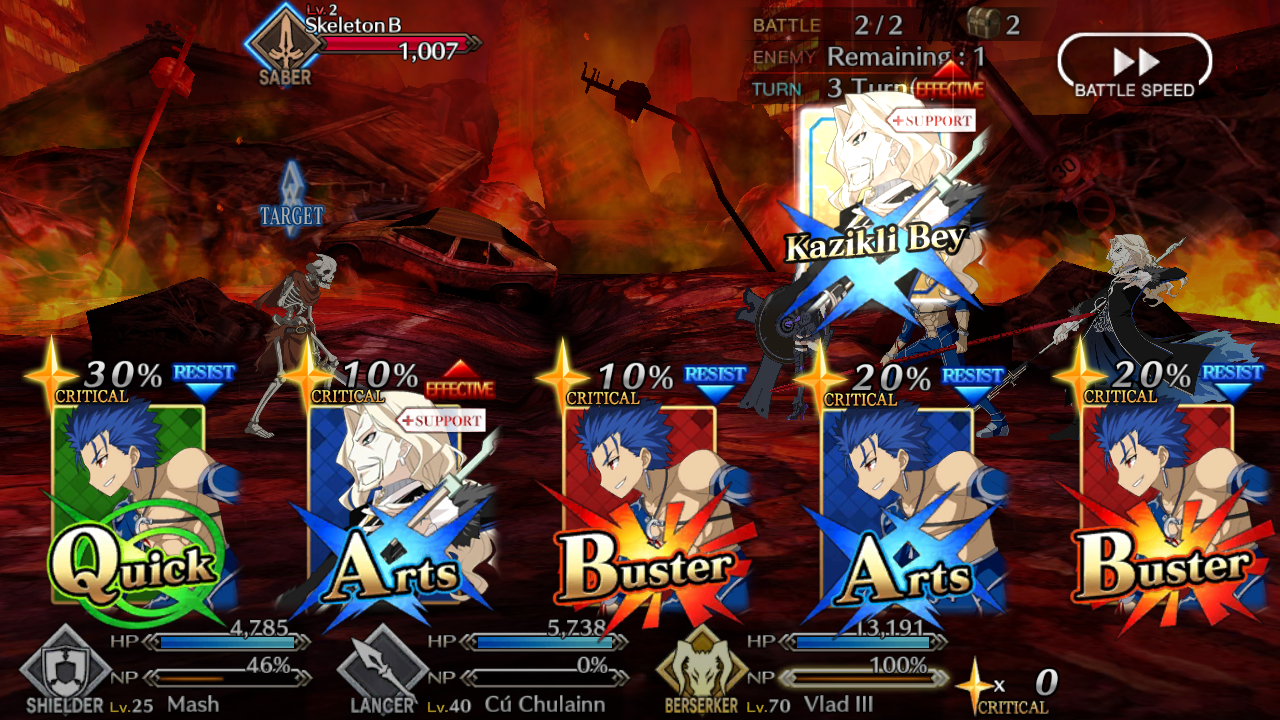
Command Cards come in three types, with each having their own unique bonus. Buster cards deal more damage, Arts cards generate more NP charge, while Quick cards generate more critical stars. The details of these properties are as follows:
| Card | Damage | NP | Stars |
|---|---|---|---|
| Buster | 150% | 0% | 10% |
| Arts | 100% | 300% | 0% |
| Quick | 80% | 100% | 80% |
Each Servant comes with a five-card deck, which contains at least one of each card type. When a party comes into battle, the three Servants’ decks are combined and shuffled, and then five cards are dealt each turn. After three turns, the now-empty card pool will be reset. Due to this mechanic, it is to some extent possible to predict which cards will appear on the next turn, helping with the decision making process.
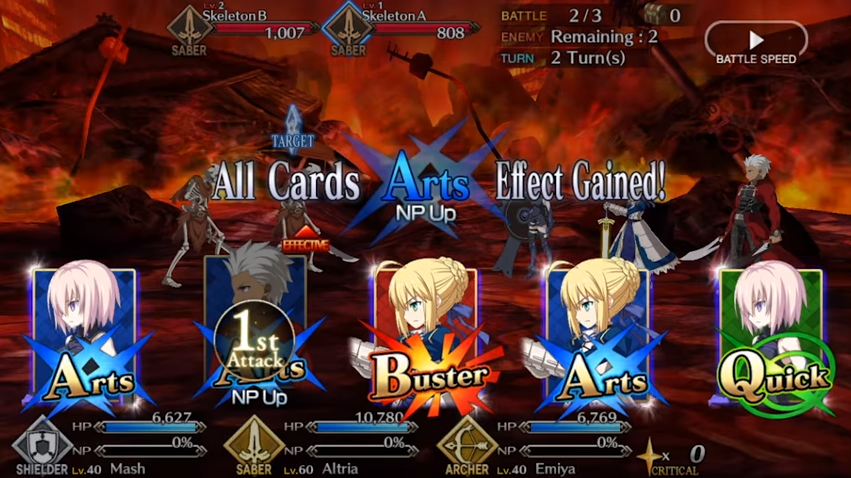
When used as the first card in a chain, each respective Command Card grants a bonus to all cards in the chain. The bonus gained depends on the card type, with Buster cards increasing damage, Arts cards increasing NP gain, and Quick cards increasing critical star gain. The details of these effects are as follows:
| Card | First Card Bonus |
|---|---|
| Buster | Adds an additional flat 50% damage increase to the card damage modifier, with no multiplicative scaling. Depending on the power of the given card, this can be approximately a 20-50% increase in overall damage. |
| Arts | Adds an additional 100% to the card's NP gain modifier. (E.g. Arts goes to 300->400%, Buster 0%->100%, Quick 100%->200). |
| Quick | 20% critical star rate. * Increase Crit Rate by 20% for all Cards (post-7th Anniversary). |
Due to their significant effects, the first card bonus allows even the most ill-suited card types to gain some benefits (e.g. Buster cards can generate NP charge with an Arts first card bonus).
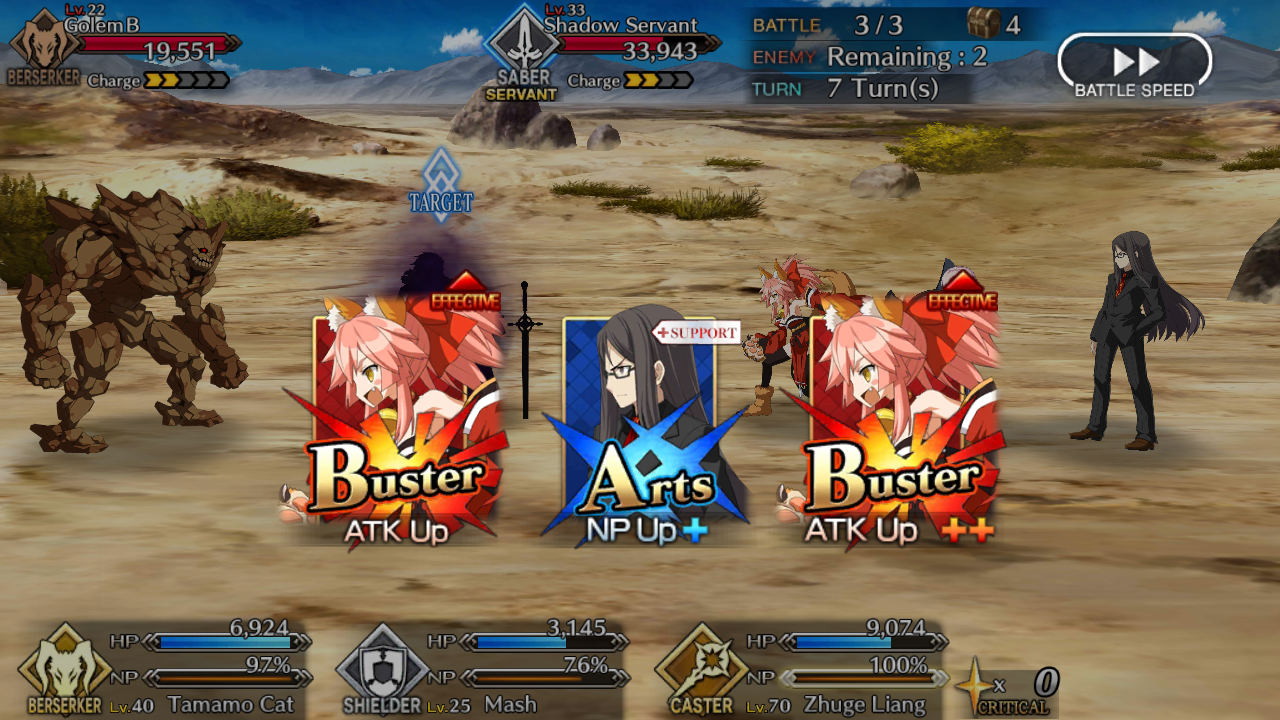
A card’s position affects its performance: a card placed in the third position would deal more damage, gain more NP charge, and gain more stars than if it were placed in the second position. As such, it is generally beneficial to put more important cards in the final slot of a card chain. However, to be noted, the first card bonus grants more to the whole chain when compared with card positioning. The details of the effects of card positioning are detailed below:
Damage
| Card | First | Second | Third |
|---|---|---|---|
| Arts | 100% | 120% | 140% |
| Buster | 150% | 180% | 210% |
| Quick | 80% | 96% | 112% |
NP Gain
| Card | First | Second | Third |
|---|---|---|---|
| Arts | 300% | 450% | 600% |
| Buster | 0% | 0% | 0% |
| Quick | 100% | 150% | 200% |
Star Generation
| Card | First | Second | Third |
|---|---|---|---|
| Arts | 0% | 0% | 0% |
| Buster | 10% | 15% | 20% |
| Quick | 80% | 130% | 180% |
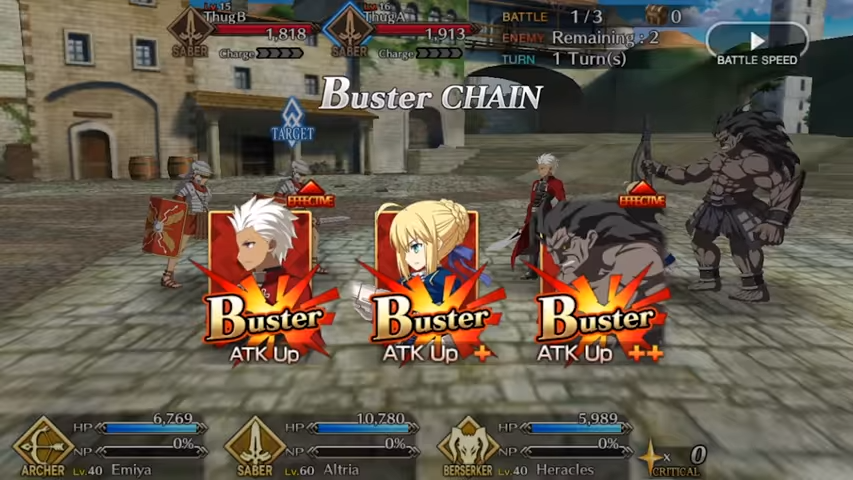
A same-type chain (alternatively known as a same-color chain) is formed when three cards of the same type are chosen. It grants an additional effect, depending on which type of cards they are:
| Card Type | Chain Effect |
|---|---|
| Quick | Grants 10 critical stars. * Grants 20 critical stars (post-7th anniversary) |
| Arts | All Servants whose cards are in the chain gain 20% NP gauge. |
| Buster | Each non-NP Buster Card gains bonus damage equal to 20% of the Servant’s ATK. This bonus damage is flat, meaning that it is unaffected by defense buffs/attack buffs, or class advantage. |
| Mighty Chain | Damage | Note |
| QAB | 560% | * Highest Damage (aside from BBB) |
| ABQ | 542% | * Highest Star Generation (aside from QQQ) |
| BQA | 536% | * Highest NP Gain (aside from AAA) |
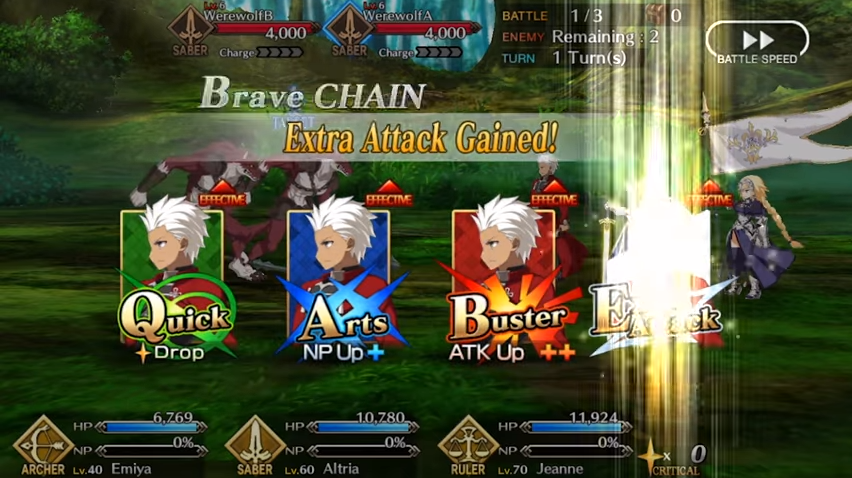
A brave chain is formed when three cards belonging to the same Servant are chosen. Upon doing so, an Extra card is added to the end of the chain, granting a fourth attack for the Servant. This Extra card functions in much the same way normal cards do in that it can benefit from buffs or effects that enhance its ability to deal damage, increase NP gauge, and generate critical stars. However, the Extra card is incapable of performing critical hits or directly benefiting from buffs that enhance a specific card's effectiveness, but it makes up for this by possessing high values in terms of its damage, NP gain, and critical star gain modifiers. In addition, a Brave Chain that's made up of a Same-Type Chain (i.e. STC) has an even higher damage modifier than normal. The specifics of the Extra card are as follows:
| Damage | NP Gain | Stars |
|---|---|---|
| 200% (350% STC) | 100% | 100% |
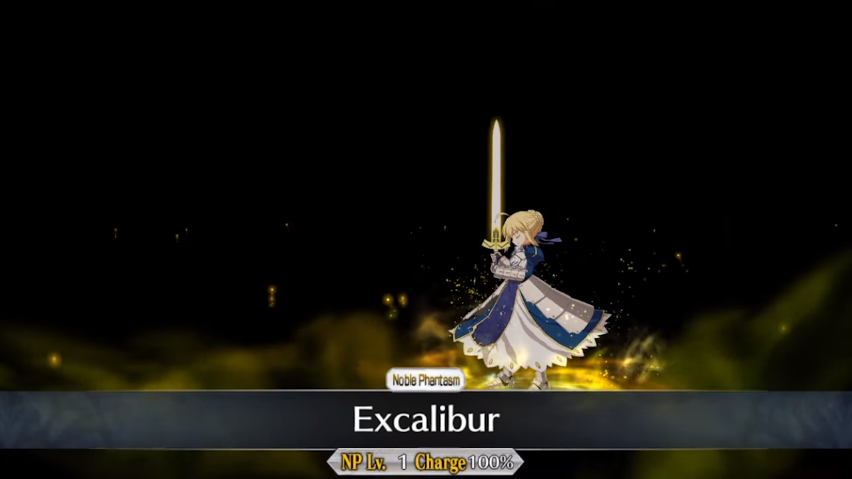
A Servant’s Noble Phantasm functions as an additional card in their pool. As such, it is able to grant First Card bonuses, and form same-color card chains. However, there are a couple of important things to be noted:
1. Noble Phantasms are always treated as the first card. This means that their performance is unaffected by their position in a card chain.
2. The Noble Phantasms themselves are not affected by the First Card bonus, nor the same-type chain bonus.
Due to these properties, it is generally recommended to put Noble Phantasms up front in a chain, except if the First Card bonus they grant is undesirable.

This chain can only be formed by using one NP directly after another one. It increases the NP’s Overcharge level for every NP before it. To be noted, however, Overcharge only amplifies the NP’s secondary effect; as such, it does not directly affect damage, unless the secondary effect is something that does so.
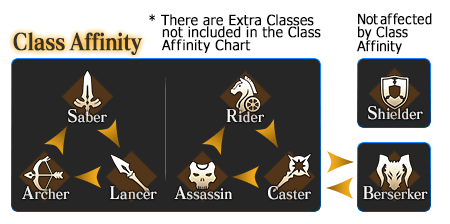
The last major part of the basic combat mechanics is the class advantage. As per the in-game guide, classes interact with each other in the style of weapon advantage. For the six normal classes (Saber, Archer, Lancer, Rider, Caster, Assassin), this translates to dealing double damage to and receiving half damage from an opponent they have a class advantage on.
Currently, the only exceptions to this are Berserkers, Rulers, and Shielders. Berserkers deal 150% damage to all classes while receiving double damage, and Rulers receive half damage from other classes except for Berserker. The Shielder class, on the other hand, deals and receives normal damage against all classes.
A thing to keep in mind is that not all Servants deal the same amount of damage, even with the exact same attacks and Servants. This is due to a hidden base damage modifier that is attached to each class. The details of these modifiers are as follows:
| Modifier | Class |
|---|---|
| 110% | Berserker, Ruler, Avenger |
| 105% | Lancer |
| 100% | Saber, Rider, Shielder, Alter Ego, Moon Cancer, Foreigner, Pretender, [Beast I~III] |
| 95% | Archer |
| 90% | Caster, Assassin |
Another modifier to damage lies in a hidden attribute for each Servant in the game. There are five attributes in total, although the Beast attribute is not currently used in the US version of the game. The attributes are as follows:
| Attribute | General Description |
|---|---|
| Earth | Servants originating from fairy tales and folklore. Deal increased damage and take less damage when fighting Man opponents. |
| Man | Servants who were actual historical figures. Deal increased damage and take less damage when fighting Sky opponents. |
| Sky | Servants associated with divine beings, typically those with Divinity. Deal increased damage and take less damage when fighting Earth opponents. |
| Star | Very significant figures representing the best of mankind. Deal increased damage to Beast opponents. |
| Beast | Harbingers of apocalypse, this trait is rarely found among normal Servants. Deal increased damage to Star opponents. |
As with Servant classes, the hidden attribute affects both damage dealt and received, though to a much lesser extent, with the damage increase and reduction being only 10%:
| ATK \ DEF | Earth | Man | Sky |
|---|---|---|---|
| Earth | 100% | 110% | 90% |
| Man | 90% | 100% | 110% |
| Sky | 110% | 90% | 100% |
Star and Beast do 110% damage to each other.